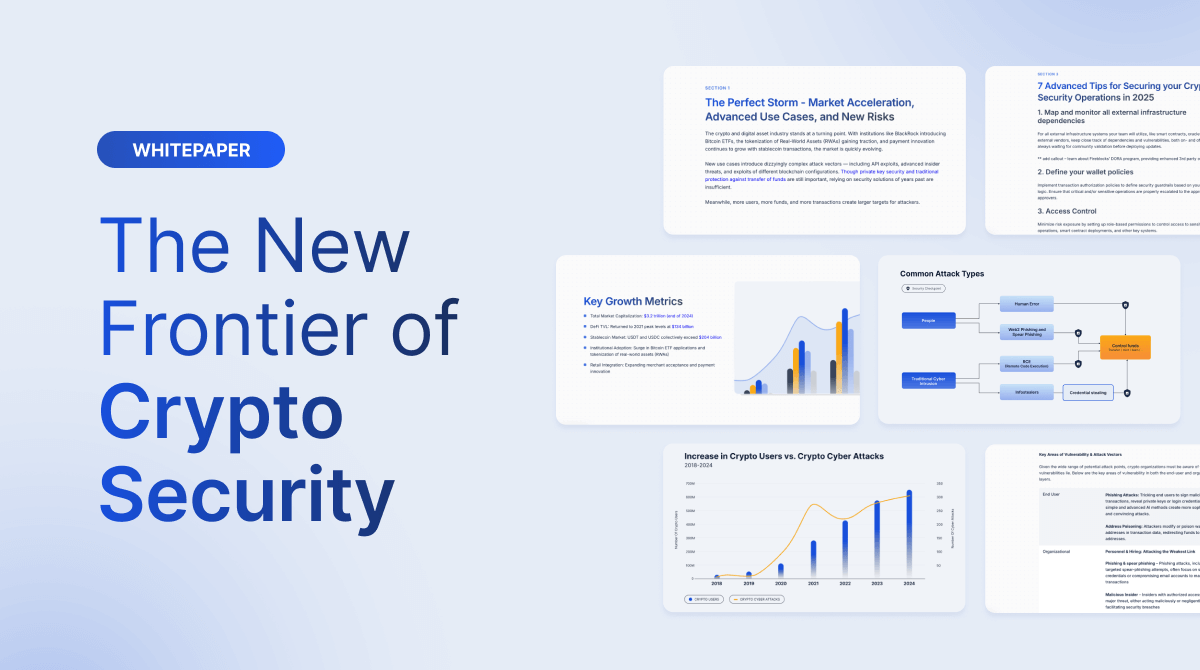Part I: Stablecoins Enter the Financial Core
The foundations of global payments infrastructure were laid over 60 years ago—and until now, they’ve remained largely unchanged. Stablecoins are becoming a key component of modern payment rails for payment providers, banks, and fintechs looking to move faster, reach new markets, and stay competitive. This report showcases an evolution from isolated pilots to readiness for scalable implementations—and the numbers speak for themselves. In 2024, stablecoins accounted for nearly half of transaction volume on the Fireblocks platform—proof that they are essential to global payments modernization.
With over 300 banks and payments providers onboard, Fireblocks processes 15% of global stablecoin volume—more than 35 million transactions every month.
Fact 1: 90% Are Taking Action—Stablecoins are powering payments today
The industry is charging forward, energized by stablecoins’ potential to reshape the global payments landscape. Among their most immediate applications is cross-border payments—spanning remittances, B2B transactions, and internal treasury—where they deliver unmatched speed, cost-efficiency, and 24/7 uptime. The industry is at a strategic inflection point: the stablecoin race has become a matter of avoiding obsolescence as customer demand accelerates and use cases mature.
90% of respondents are taking action on stablecoins
While domestic payment systems in many regions now support instant settlement, international flows remain constrained by fragmented legacy rails, which rely on correspondent banking networks that introduce delays, lack transparency, and impose high FX costs.
As a result, cross-border payments are driving adoption —particularly when orchestrating high-volume B2B flows in emerging market corridors. Conduit, for example, has seen growing adoption among B2B customers—particularly import/export businesses in Latin America and Africa—integrating stablecoins into their payment operations.
Traditional banks are 2x more likely to prioritize cross-border payments over any other use case
For banks, stablecoins offer a path to modernization. As fiat-pegged assets, they are easier to integrate into existing treasury workflows and offer a strategic lever to reclaim lost market share from fintechs, unlock new corridors, and reduce capital lock-up.
With EURI, we’re not just launching one of the first MiCA-compliant stablecoins; we’re setting a new standard for the region. As the first European bank to issue a regulated e-money token, we’re bridging traditional finance and Web3. EURI is a tool that brings utility such as faster cross-border payments, smart escrow solutions, and seamless transactions across tokenized platforms.
Fact 2: 48% Say Speed Is the Top Benefit—Lower Costs Cited Last
Stablecoins are emerging as strategic growth enablers to expand into new markets and meet growing customer demand. Banks are using them to regain lost cross-border volume while maintaining existing infrastructure, while fintechs and payment gateways aim to reach revenue and margin gains.
Respondents are 1.5x more likely to value speed over savings in stablecoin benefits
The most cited benefits include faster settlement (48%), improved liquidity (33%), and integrated flows (33%). Cost savings, at 30%, rank lowest—highlighting a shift toward performance, control, and scalability as primary goals.
Revenue opportunity is the #1 motivator overall: 3 of the top 4 drivers are tied to growth
The fastest-moving organizations see stablecoins as both an offensive and defensive strategy. Banks prioritize market expansion and regulatory fit, while fintechs focus on cost efficiency and top-line growth.
Boards at major payments enterprises recognize that adopting stablecoins is a strategic necessity. They look to retain competitiveness against new crypto-savvy entrants and tap into new client bases and markets that are increasingly aligned with digital asset ecosystems.
Fact 3: 86% Report Infrastructure Readiness—it is Time to Execute
86% of firms report their infrastructure is ready for stablecoin adoption, shifting the focus from pilots to execution. Success now hinges on scale—integrating stablecoins into treasury, risk, and compliance systems.
Early “crypto-remote” models—where firms rely on third-party custody while keeping digital assets at arm’s length—are giving way to deep ERP integration, automated liquidity, and full compliance. As firms build confidence, adoption is accelerating—driven by strong partners, technical maturity, and rising market demand.
Stablecoin Adoption Confidence Is At All-Time High: Fewer Than 1 in 5 Cite Infrastructure or Compliance As a Barrier
Our priority has been to integrate innovation at the right moment, when it delivers real value at scale. That moment is now. With strong merchant demand, solid infrastructure, and clearer regulation, stablecoins are now a natural fit for our global payment network, helping us move faster, operate more efficiently, and reach further.
Fact 4: 9 in 10 Say Regulations and Industry Standards Drive Adoption
Confidence in stablecoins is rising—not just because of progress, but because key barriers have receded. Fewer than 1 in 5 firms now cite regulation or compliance as a barrier, down from 80% two years ago. This shift reflects a wave of clear national policies, improved AML tooling, and the rise of international standards.
Confidence surges: regulatory and compliance concerns cut by over 50% since 2023
9 in 10 cite regulatory clarity and standards as adoption catalyst
This shows that regulation is no longer just policy-driven—it is being translated into usable infrastructure. The rise of regtech, chain analytics, and automation tools means firms can now operationalize compliance across their systems.
Part II: Local Drivers, Global Momentum: Regional Realities Are Shaping the Stablecoin Race
Stablecoin adoption isn’t a single global sprint—it’s four parallel races toward the same finish line, each shaped by local market needs and regulation.
Latin America is sprinting ahead to meet demand, Asia is running a relay fueled by trade flows, North America is leaping over regulatory hurdles, and Europe is pacing itself through a marathon under a clear framework.
Fact 5: Latin America Leads in Real-World Use: 71% Use Stablecoins for Cross-Border Payments
Latin America is out in front when it comes to implementation. 100% of the survey’s respondents in the region are either live, piloting, or in the planning stages with their stablecoin payments strategy. Equally notable: 92% say their wallet and API stack is ready now, reinforcing the technology readiness in the region.
By combining stablecoins with local payment rails, we’re unlocking a powerful cross-border experience—something traditional banking infrastructure simply can’t deliver.
Fact 6: Asia’s Growth Focus: 49% Say Market Expansion Is the #1 Stablecoin Driver
For payments players catering to the region’s ecommerce merchants, exporters, gig workers, and digital-first entrepreneurs, stablecoins represent more than a technological shift. They are essential for moving money rapidly and transparently in an increasingly interconnected world.
Adoption stands at 53%—in lockstep with its ambitious and innovative customers—and the region ranks second globally for technology readiness (87%). The signals are clear. The region is hyper-focused on scaling through expansion into new markets.
Global trade corridors move billions daily—and now they’re doing it faster with stablecoins. Adoption is being driven by traditional B2B players like ship brokers and steel traders, not just crypto or tech firms. The infrastructure is in place, and the value is clear.
Fact 7: 88% of North American Firms See Stablecoin Regulation as a Green Light, Not a Barrier
Adoption in the region is keeping pace with global trends at 50%. Regulatory clarity has historically been a factor—but the region is turning a corner, with 88% of North American respondents viewing upcoming stablecoin regulations favorably.
North America has already laid the groundwork: infrastructure is mature, institutions report high readiness, and firms are beginning to operationalize stablecoins across a wide range of payment flows—from customer-facing transactions to internal treasury.
North America is embedding stablecoins into everyday payment flows—beyond cross-border corridors
ALT 5 Sigma, a Nasdaq-listed B2B crypto payments processor, has seen explosive growth since entering the space. In 2020, they had $39M in volume. Today, there’s been a seismic shift–transaction volume surged to over $2B in 2024. With Fireblocks’ infrastructure to handle wallet security, high TPS demands, and seamless merchant onboarding, ALT 5 is focusing on merchant growth while earning trust from institutional partners and investors.
Fact 8: In Europe, Security Is the Strategy—42% Cite Legacy Risks, 37% Demand Safer Rails
Europe has the clearest regulatory path, due to MiCA and parallel efforts in the UK. Only 18% of European respondents view regulation as a barrier to adoption. Implementation is unfolding at a deliberate pace with 58% using or planning to use stablecoin payments today. What is propelling adoption is not hype—it is competitive pressure. 37% of European firms cite competitive pressure as their top adoption driver, more than any other region. And as adoption grows, one theme is rising to the surface: security.
Part III: Infrastructure Will Decide the Winners in Stablecoin Payments
A deeper question emerges—not only whether firms can deploy stablecoins, but what infrastructure they will build on to scale its adoption.
This is where infrastructure comes into focus. Internal capability—systems, pilots, trained teams—gets you to the starting line. Competitive advantage lies in external platforms that support liquidity, compliance, and seamless execution.
The shift underway is strategic: from isolated deployments to ecosystem decisions. Infrastructure is no longer a technical detail. It is a defining factor in who leads the next phase of digital finance.
Fact 9: Stablecoin Infrastructure Must Be Enterprise-Grade — 41% Say Speed, 34% Say Compliance Are Non-Negotiable
As stablecoins move into critical payment flows, operational pressure increases. Firms are now looking for platforms that are secure, compliant, and capable of high-throughput transactions.
This evolution is what elevates stablecoins into the financial core—not only in theory, but in infrastructure demand. Today’s market expects enterprise-grade performance that can meet the complexity, velocity, and regulatory scrutiny of global commerce.
Zeebu, a blockchain-based telecom payments platform, used Fireblocks to scale its cross-border settlement system—processing $5.7B in transactions and settling 99,000 B2B invoices across 139 active carriers. For Zeebu, stablecoins aren’t about trimming costs—they’re unlocking growth, reach, and revenue in a $120B global market.
Fact 10: Security Drives Scale—36% Say Better Protection Would Unlock Adoption
Stablecoin adoption hinges not only on innovation, but on trust. And risk is a gating factor for enterprise-grade deployments.
Conventional security frameworks will not be sufficient to protect the next billion users as stablecoin adoption accelerates. To keep up with 24/7 cross-border flows, infrastructure must evolve at the same pace as the attack surface. Institutions are no longer asking if a provider is secure, but how that security evolves to meet emerging threats.
Through our work supporting stablecoin adoption across payment providers and banks, we’ve observed a clear progression: firms begin with security concerns, build confidence as they move into production, and ultimately recognize that enterprise-grade security is fundamental to scaling stablecoin operations with reliability and resilience.
Conclusion: From Proof of Concept to Proof of Priority
This report’s data confirms what many industry leaders already suspect: stablecoins are no longer a fringe innovation—they’re fast becoming core infrastructure for payments, treasury, and liquidity strategy. From instant settlement and improved capital efficiency to programmable flows and global reach, the use cases are mature and the competitive pressure is mounting.
For financial institutions, payment providers, and fintechs alike, the strategic imperative is unmistakable: stablecoin adoption is not a question of if, but of how to execute.The firms investing in infrastructure today—wallets, compliance, and rails—will be the ones powering the next era of digital finance.
ABOUT THE SURVEY
The findings of this research are based on an online survey conducted by an outside research company in March 2025. Most of the 295 participants (61%) are C-suite executives—the remainder are heads of strategy, innovation, or product or specialists in the payments, finance, compliance, or legal functions. They work for traditional banks, cryptocurrency services providers, challenger banks, or non-bank payment service providers, including merchant account providers and payment gateways.



